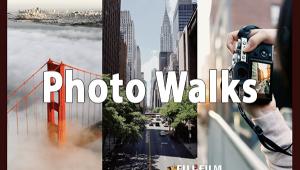It’s That Time Again
As 2015 draws to a close, it’s once again time to reflect upon the past 12 months and make some resolutions for the coming year. We’ll leave it up to you to set personal goals for exercising more, eating less, and quitting smoking, and instead offer a few suggestions for improving your enjoyment of photography in 2016.
Back to Basics
No matter how adept you are as a photographer, every so often it pays to review some of the more basic tenets of our craft and make sure that sophisticated creative concerns aren't getting in the way of basic principles. Perhaps nowhere is this truer than in the realm of composition, so here are a few reminders:
- Choose a Focal Point—Most great shots begin with an eye-catching point of interest. This focal point could be a person, a building, or a majestic mountain, but, in any case, avoid placing it in the center of your frame.
- Think Vertical—Photographers often end up with mediocre images because they forget to consider a vertical, rather than horizontal orientation. Remember to experiment with both vertical and horizontal shots of the same scene; your results may surprise you.
- Move in Tight—People pictures are almost always more interesting if you move in as tight as possible to your subject. You can do this simply by physically moving closer to your “model” or by using a telephoto lens.
- Think About Contrast—A simple technique for adding compositional interest to your photos is to concentrate on accentuating contrasts: light vs. dark areas, large vs. small elements, etc.
- Don’t Forget Framing—Try finding a device to frame your subject for added compositional unity. The overhanging branches of a tree, for example, can add a pleasing effect as they frame a distant landscape.
What About Video?
Virtually all of today’s digital cameras (DSLRs, Mirrorless Models, and advanced point-and-shoot pocket cameras) offer some very sophisticated video capabilities. Yet, many of us ignore these options and concentrate solely on shooting stills. Whether you’re shooting sports, family events, wildlife or travel activities, mixing in a bit of live action can be a lot of fun and open up a whole new realm of possibilities. Some of the more advanced cameras even enable you to capture a relatively high-resolution still frame from your videos. In short, you already own the camera, so why not sit down, review your manual and give videography a try? We’re committed to helping you out by offering enhanced video instructional articles in the magazine and on our website, as well as a monthly tutorial to get you started.
Two For The Price Of One
Another characteristic of the latest digital cameras is the high resolution they offer; long gone are the days when your DSLR barely had enough resolution to make a high-quality 8X10 print at 300dpi. Even if you don’t have a large format printer to take advantage of all the pixels at your disposal, here’s a way to challenge your creativity and make use of your camera’s hi-res capabilities. Give yourself the assignment of finding and shooting scenes in which you can crop out two interesting images from a single exposure. This is something I did on occasion in the film days while shooting with a 6X7 medium-format camera and it’s more difficult than you may think. But the challenge opens your eyes to a new way of visualizing your surroundings. For obvious reasons, the use of a wide-angle lens makes the task a lot more manageable.
Back-And-White
Some scenes simply look better in black-and-white, yet it’s surprising how few digital photographers only shoot in color. And you really don’t have to drop six-grand on a Leica M Monochrome camera to prove this to yourself. Virtually every camera out there, including inexpensive point-and-shoot models, have a black-and-white mode that enables you to experiment with monochrome photography at the push of a button. Same for whatever image-editing software you use. There are also some very sophisticated and easy-to-use Photoshop plug-ins that provide remarkable creative control and film emulations for black-and-white photography. Again, this assignment will help you develop your “art of seeing” and you might just end up with some fantastic results.
Leave The Selfie Stick At Home
Enough said.
















































